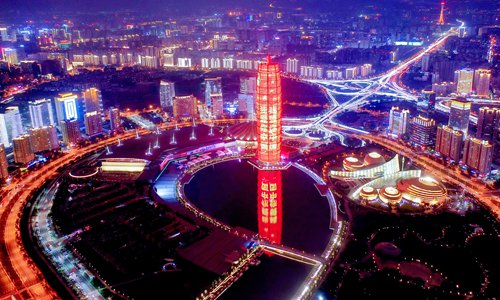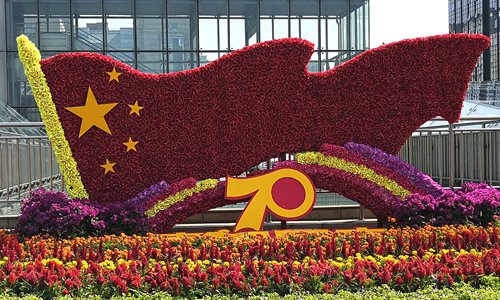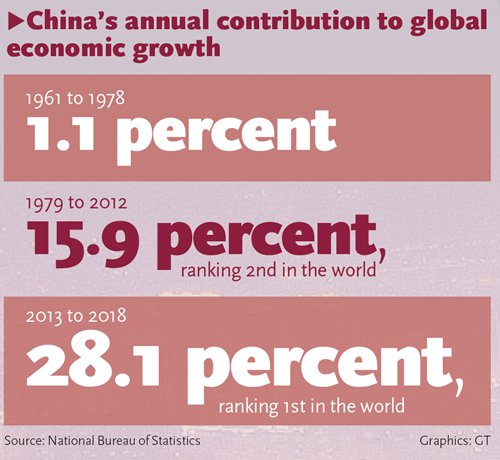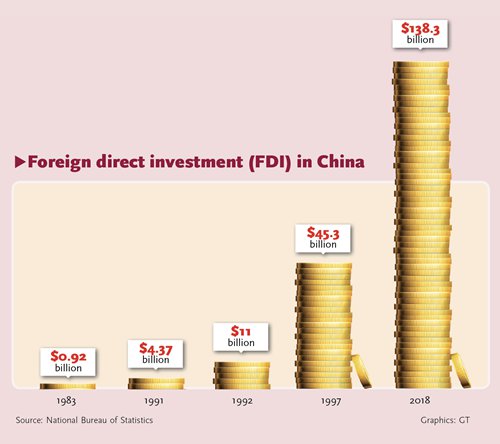HOME >> BUSINESS,SPECIAL-COVERAGE
China’s economic rise over 70 years
Source:Xinhua-Global Times Published: 2019/9/22 19:48:40
Country benefits domestic people, global economy

Characters seen on a building in the city center of Zhengzhou, Central China's Henan Province read "I love you China" in a celebration of the 70th anniversary of the founding of the People's Republic of China on Friday Photo: VCG

Photo: VCG
Editor's Note:
Developed from being a predominantly agricultural economy to the world's factory and beyond, over the past 70 years, China has showed the world how it made an economic miracle through the central government's bold and resolute economic reform as well as its people's hard work. While that economic success not only brings the country improved living standards and a rising urbanization rate, it also has attracted a surging number of foreign companies to enjoy that dividend and grow together with China.
What has China achieved so far? A slew of data and information revealed by the National Bureau of Statistics could shed some light on that question.
Soaring economic growth
China has ranked first in terms of contribution to global economic growth since 2006, becoming the leading engine of world economic growth, an official report said Thursday.
In the past 70 years, China's proportion of major economic and social aggregate indicators in the world has further increased, its international status has been further enhanced, and its global influence has continued to grow, said a report released by the National Bureau of Statistics.
The report shows that from 1961 to 1978, China's average annual contribution to global economic growth was 1.1 percent, but from 1979 to 2012, the average annual contribution rate was 15.9 percent, ranking second in the world.
From 2013 to 2018, the average annual figure climbed to 28.1 percent, ranking first place globally, the report said.
In 2018, the ratio of China's contribution to global economic growth was 27.5 percent, 24.4 percentage points higher than in 1978, the report said.
Over the past 70 years, China's economic strength has grown remarkably.
In 1952, China's GDP was $30 billion, while in 2018, its GDP reached $13.61 trillion, an increase of 452.6 times.
In 1978, China's GDP ranked 11th in the world, while in 2010, it overtook Japan to become the second largest economy in the world, and has remained the second largest economy since then.

Increasing jobs and living standard
China's economy and society have undergone a sea of changes in the past seven decades, and so have people's occupations.
In the early years after the People's Republic of China was founded in 1949, the majority of the population worked as farmers. At that time about 180 million people were employed, and only 8.3 percent of them worked in urban areas, data from the National Bureau of Statistics (NBS) showed.
In 2018, the country's employed population surged to 780 million, with over 56 percent working in cities.
Given the huge size of the Chinese population and the challenges of transforming from a planned economy to a market economy capable of pursuing high-quality development, China has been largely successful in keeping employment stable over the past 70 years.
On top of that, China has seen constant improvement in its employment structure, with new jobs popping up as a result of an evolving economy.
There was no standard classification for jobs in 1949. A popular saying of "360 professions" generalized the various occupations before 1999, when China released an official reference book on occupations.
An updated version of the reference book was rolled out in 2015, with 526 manufacturing jobs such as open-hearth steelmaker becoming obsolete, while some 81 new service-related professions such as courier were included.
The rising urban demand for services has attracted farmers like Chang Baohong to seek job opportunities in cities. The 34-year-old man is now a deliveryman working for the country's largest online food delivery-to-ticketing services platform Meituan Dianping, and he can deliver 50 orders per day with the help of smart apps.
In 2018, around 46 percent of the employed people worked in the tertiary industry in China. "This is an indicator of China's transformation to a service-based economy," said Lai Youwei, head of Meituan Research Institute.
Unlike Chang, entrepreneurial Liao Zaijie, who calls himself a "new farmer," chose to seek his fortune in the country's rural areas.
Encouraged by the country's mass innovation and entrepreneurship campaign, Liao decided in 2015 to return to Hubei Province's countryside to start his own business by helping local farmers sell agricultural products through e-commerce platforms.
As of June this year, Liao's sales volume on Pinduoduo, a social e-commerce giant with a huge consumer base in rural areas and small cities, reached 65 million yuan (about $9.16 million).
By the end of 2018, a total of 7.8 million people like Liao had returned to their rural hometowns to start businesses, promoting the application of new technologies, new varieties and expanding new markets, NBS data showed.
To keep pace with economic and technological development, China added 13 new professions to the occupation dictionary in April, featuring a series of high-tech occupations including artificial intelligence technicians, Internet of Things technicians, cloud computing technicians, electronic sports specialists and unmanned aerial vehicle pilots.
As the Chinese economy is shifting from high-speed growth to high-quality development, new jobs requiring new skills and knowledge have appeared in various industries, attracting a relatively stable number of workers, according to the Ministry of Human Resources and Social Security.
Thriving foreign investment
Since the first foreign-invested company entered China about 40 years ago, China's economic development has been closely connected with foreign investors.
Expanding scale
After China started to implement the reform and opening-up policy in the late 1970s, it soon enforced the law on equity joint ventures, laying the legal foundation for attracting foreign investors.
From 1983 to 1991, foreign direct investment (FDI) in China went from $920 million to $4.37 billion.
As China started to work toward building a socialist market economy in 1992, a total of 48,764 foreign-invested enterprises were registered that year, surpassing the total amount for the previous 13 years.
From 1992 to 1997, FDI in China surged from $11 billion to $45.3 billion, growing at an average annual rate of 32.7 percent.
After China entered the WTO in 2001, foreign business giants started to set up wholly foreign-owned enterprises, equity joint ventures and contractual joint ventures in the country.
In 2018, FDI into China reached $138.3 billion, 151 times that of 1983 and representing an average annual rate of 15.4 percent.
By the end of 2018, FDI inflow to China had ranked second in the world for two consecutive years and first among developing countries for 27 consecutive years.
Over 960,000 foreign-invested enterprises had been set up in China by the end of last year, with the accumulated foreign direct investment exceeding $2.1 trillion.
At present, the country has attracted investment from over 200 countries and regions. In 2018, major investments came from Asia, the European Union, North America and free port areas.

Increasingly diverse business
Starting along the southeastern coast of China about 40 years ago, the foreign companies have extended their businesses from labor-intensive industries, especially the manufacturing sector, to industries ranging from services to high technology.
As service industries such as information, finance, wholesale and retail, accommodation and catering sectors attract more investment, the tertiary sector has become the main destination of foreign investment in China.
Last year, 53,696 new foreign firms in the service sector were registered, accounting for 88.7 percent of all newly registered foreign-invested companies.
So far, foreign investment has spread to high-tech sectors including computer, integrated circuit and intelligent manufacturing.
Today, China is home to more than 2,000 regional headquarters and R&D centers of multinational companies, seeing improved quality in utilizing foreign investment as well as optimizing the structure of industries.
Emerging in the southeast regions of China, foreign investment moved inward along the border and the rivers of the country as well as to port cities.
In 2018, investment in the eastern region accounted for 85.5 percent of the total foreign investment, while the central and western regions attracted 17.9 percent and 20.4 percent of the total.
Bright future
China has been making consistent efforts to optimize its business environment and embrace investors worldwide. The country advanced to a global ranking of 46 in terms of ease of doing business last year, up from 78 in 2017, according to a World Bank Group report.
In March 2019, China's national legislature passed the foreign investment law, the landmark legislation for foreign investment, which will come into effect on Jan. 1, 2020.
According to the law, China will create a stable, transparent, predictable and fair market environment.
The country will set up six new pilot free trade zones to bring the total number to 18, which serve as pioneers to test new forms of foreign investment management, trade facilitation and transformation of government functions.
The country will also lift the investment quota limit for approved foreign investors to boost financial reform and opening up.
Determined to safeguard free trade and integrate itself into economic globalization, China will continue its win-win cooperation with investors around the world.
Xinhua - Global Times
Posted in: INSIGHT